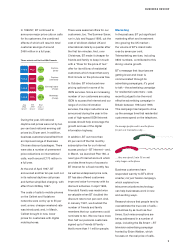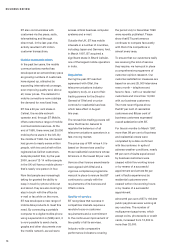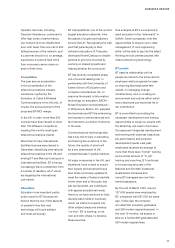BT 1997 Annual Report Download - page 19
Download and view the complete annual report
Please find page 19 of the 1997 BT annual report below. You can navigate through the pages in the report by either clicking on the pages listed below, or by using the keyword search tool below to find specific information within the annual report.
FINANCIAL REVIEW
19
% return on capital
employed
13.6
17.1
15.6
18.3
18.9
93 94 95 96 97
Acquisitions and joint ventures
In April 1996 the group acquired the Rijnhaave group,
a Netherlands-based systems integration business
and, in March 1997, completed the formation of a joint
venture with the Dutch railways organisation to offer
telecommunication services in that country. In February
1997, BT agreed to acquire the 50% interest in its
Spanish joint venture it did not already own, thereby
obtaining full control. Also, in March 1997, the group
acquired a 22.5% interest in Bharti Cellular, a mobile
telecommunications operator based in India. The goodwill
arising on these acquisitions amounted to £166 million;
the remaining goodwill of £33 million taken to reserves in
the year mainly related to BT’s share of goodwill arising
on MCI’s acquisitions, principally on its new joint venture
in Mexico.
In September 1996, BT announced that it would
be taking a 26% interest in CEGETEL, the French
telecommunications operator which has a majority
interest in SFR, a leading mobile provider in France, for a
consideration of approximately £1 billion. This transaction
is due to be completed later in 1997.
Return on capital employed
The group made a return of 18.9% on the average capital
employed, on a historical cost basis, in its business in the
year ended 31 March 1997, compared with a return of
18.3% in the previous year.
Pensions
BT has recently received the preliminary results of an
actuarial valuation, as at 31 December 1996, of its main
pension fund made for the purposes of determining the
future pension charges in the accounts of the group.
These results revealed the fund to be in surplus to an
amount of approximately £600 million, with assets of the
fund at £19,879 million covering 103% of the fund’s
liabilities, in contrast to an asset coverage of 97% at
31 December 1993. The surplus principally arose from the
return on the fund’s assets in the three intervening years
being higher than the long-term actuarial assumptions.
The major assumptions used in the December 1996
valuation were that, over the long-term, the return on the
existing assets of the fund, relative to market values,
would be 8.2% per annum and on future investments the
return would be 8.7% per annum (allowing for real equity
dividend growth of 0.5% per annum), the retail price index
would increase at an average of 4.0%, and wages and
salary rates would increase at an average of 5.8%.
From 1 April 1997, the annual pension charge based on
the December 1996 valuation is expected to be lower than
the charge of £291 million in the year to 31 March 1997.
This revised charge will take into account the amount of
the pension provision which has been established over the
past eight years in the group’s accounts and which stood
at £1,291 million at 31 March 1997. Additionally, from
1 April 1997, in accordance with current UK accounting
standards, the cost of providing incremental pension
benefits for early leavers will no longer be charged against
the profit in the period in which people leave, whilst the
most recent valuation shows the fund to be in surplus.
BT expects to continue making cash contributions to its
fund at broadly the current level of 9.5% of pay in order to
maintain the fund’s financial strength.
























